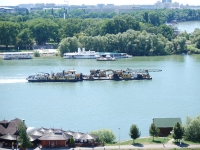 Belgrade Overview'Come to a city where you will feel at home.' This is the call
put out by the Tourism Organisation of Belgrade on its website, but
one that potential visitors to Serbia's capital may feel is rather
exaggerated, given the city's reputation as one of the most
turbulent European cities. The history of Belgrade, originally
known as Singidunum, goes back 6,000 years; the tales of conflicts
and devastation it has experienced in all that time would fill many
tomes. Belgrade, however, always bounces back and is currently
lifting itself up and shaking itself off amid the scars of its most
recent conflagration, when NATO forces bombed the city for 78
straight days in 1999. Belgrade (or
in Serbian) is situated in a strategic spot of
south-eastern Europe where the Sava and Danube rivers join on the
Balkan Peninsula. It is not a pretty city, but rather one layered
with the relics of its many generations and invaders, resulting in
a conglomeration of architecture and cultures, which have somehow
melded together to imbue the modern city with its own unique charm.
From the pile of rubble, which is all that remains of the
bombed-out former military headquarters on Kneza Milosa, to the
techno wildness of its famed nightclubs beneath the Kalemegdan
Citadel, Belgrade tells many stories and offers dozens of
experiences. The best place to begin understanding the city is on the site of
its original ancient settlement, the hill called Kalemegdan, now a
fascinating park-like complex of historic buildings above the Old
Town (Stari Grad). The Military Museum situated here traces the
history of the city's bloody past, from its first conflict with the
Roman Legions in the 1st century BC, to an exhibit of parts of a
United States Stealth Bomber, shot down in the 1999 air raids. Those who choose to ignore history and enjoy Belgrade as it is
today will find a myriad of leisure and pleasure opportunities, all
offered by the incredibly hospitable inhabitants who are justly
proud of this indomitable city. |